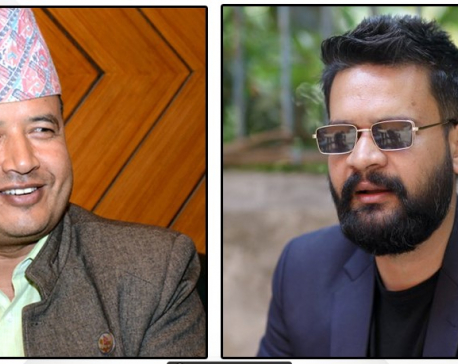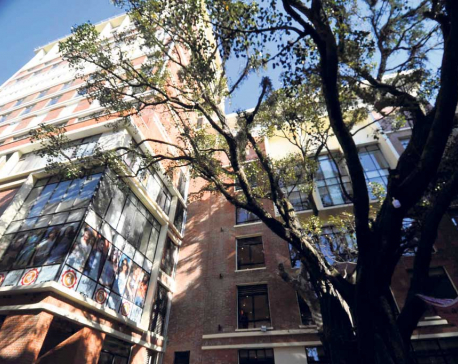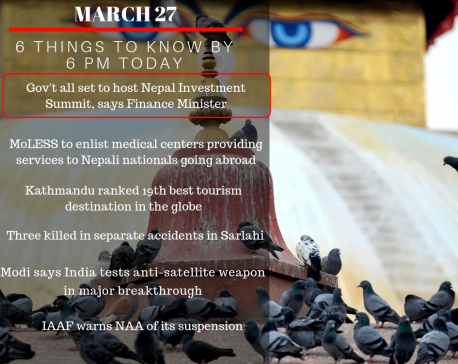
OR
Kathmandu is stinking. Do something
Published On: July 2, 2019 02:00 AM NPT By: Republica | @RepublicaNepal
Kathmandu has started to give off foul stench. Once again, heaps of garbage are seen lying on the streets, uncollected for days on end, leading to accumulation of more filth and garbage every other day. Piles of wastes lie inside the households of Kathmandu. This may lead to the outbreak of serious epidemic if the problem is not solved on time. The situation becomes much worse in monsoon. The cause of the stench this time around has been the same as in the past. Locals of Sisdol, Kakani Rural Municipality of Nuwakot district, where the landfill site is located, have risen in protests demanding compensation from the government for the inconvenience caused by the landfill site. Their other demands include health insurance for locals and a 25-bed hospital in that area. From Kathmandu’s perspective, it might seem like Sisdol residents are being stubborn, creating unnecessary troubles and they have made the landfill issue a bargaining chip to get their demands met. But let us also be mindful of how landfill has affected their health and wellbeing. The whole of the area stinks with the unbearable stench of wastes dumped from various parts of Kathmandu.
It is depressing that Kathmandu Metropolitan City authority, including Kathmandu’s Mayor Bidya Sundar Shakya, did not take measures to talk to these locals immediately. The authority should have sprung into action right after Sisdol locals rose in protest. The delay in resolving the issue is going to result in grave public health hazards in Kathmandu. There is a real possibility of contagious disease spreading because of monsoon rain. The valley produces around 1,000 metric tons of garbage per day. The figure reaches around 1,200 metric tons during monsoon. While it is extremely necessary for the government and KMC to immediately hold talks with the locals and settle this issue permanently, it is as much necessary for the authority to find alternative ways of managing wastes of Kathmandu.
Some measures could be effortless. Waste sorting, for example, could be one. If the KMC can make it mandatory for the households to segregate biodegradable wastes (such as kitchen wastes, vegetables, papers etc) from the non-biodegradable ones (such as plastics, metals etc), and if the KMC can arrange for collecting these two types of wastes separately, the former can be used for making manure, fertilizers and bio-gas. It could go a long way in minimizing the waste hazards of the valley. KMC itself has set the example of this by generating electricity through wastes. Under Integrated Sustainable Solid Waste Management Project, KMC started generating 14 KW of electricity from 2017. If such initiative can be expanded in all parts of the valley and outside, Nepal can be made much cleaner. Visit Nepal Year 2020 is only a year away. The government is talking about hosting International Indian Film Academy award ceremony in Kathmandu (the issue has courted controversy over financing matters) with the view to promoting tourism. No tourism-promotion initiatives will succeed when we keep the city covered with filth and leave it to stink. The government, together with KMC, must spring into action immediately to remove garbage heaps from the streets of Kathmandu and ensure that such problems do not recur.
You May Like This

UML leader Basnet to Balen: Don't be pampered just because you have a few hundred fans on Facebook
KATHMANDU, August 26: While the Mayor of Kathmandu Metropolitan City (KMC), Balendra Shah, is speeding up the work to demolish... Read More...

117 years of land grab in Kathmandu
Heritage site of Kamalpokhari in Thamel has become the representative case of how rich and powerful connive to get public... Read More...

March 27: 6 things to know by 6 PM today
Your daily doze of missed important news of the day. ... Read More...



Just In
- World Malaria Day: Foreign returnees more susceptible to the vector-borne disease
- MoEST seeks EC’s help in identifying teachers linked to political parties
- 70 community and national forests affected by fire in Parbat till Wednesday
- NEPSE loses 3.24 points, while daily turnover inclines to Rs 2.36 billion
- Pak Embassy awards scholarships to 180 Nepali students
- President Paudel approves mobilization of army personnel for by-elections security
- Bhajang and Ilam by-elections: 69 polling stations classified as ‘highly sensitive’
- Karnali CM Kandel secures vote of confidence















Leave A Comment